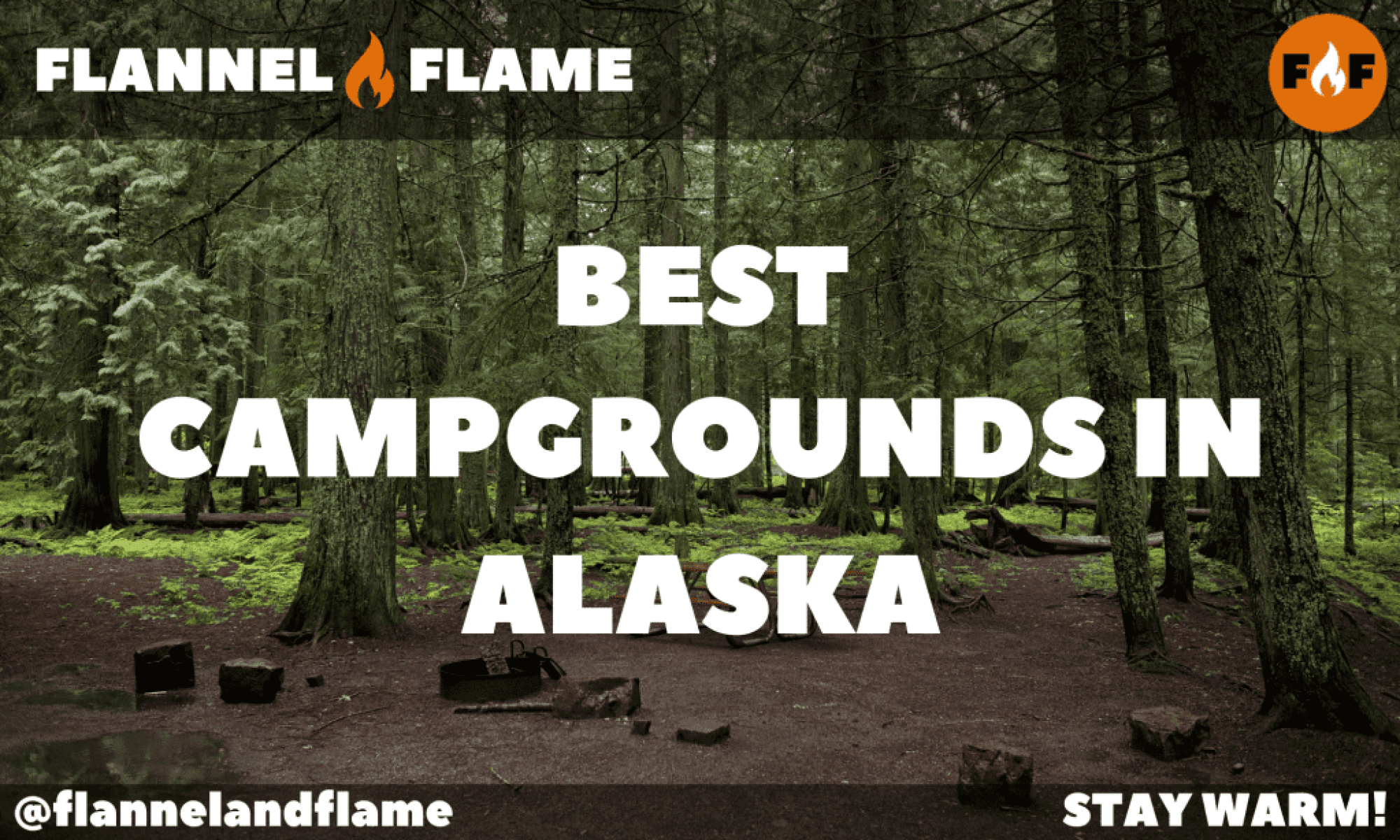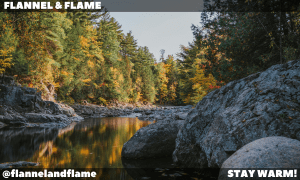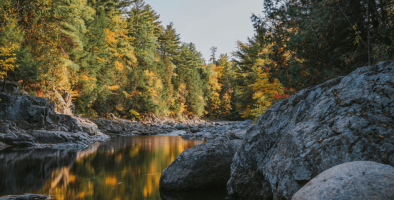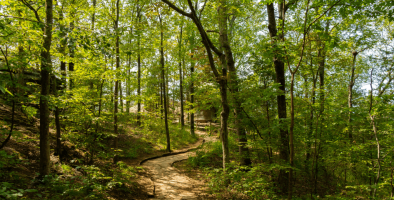Best Campgrounds in Alaska
Alaska’s wild frontier offers camping experiences that exist nowhere else on Earth. In the Last Frontier, camping isn’t just an activity—it’s an immersion into some of the planet’s most pristine wilderness, where glaciers carve valleys, northern lights dance across star-filled skies, and wildlife roams freely as it has for millennia. From coastal rainforests to alpine tundra, Alaska’s campgrounds provide front-row seats to nature’s grandest spectacles. Let’s explore the best places to pitch your tent or park your RV in America’s wildest state, where every campsite tells a story of untamed beauty and adventures waiting to unfold.
Denali National Park Riley Creek Campground
Campsites: 147
Reservations: National Park Service Reservation System
Address: Mile 0.25 Denali Park Rd, Denali National Park, AK 99755
Serving as the gateway to six million acres of wild Alaskan wilderness, Riley Creek Campground welcomes travelers to the legendary Denali National Park with a perfect blend of accessibility and immersion in nature. Nestled among spruce forests just inside the park entrance, this campground offers your first glimpse into the ecosystem dominated by North America’s highest peak.
The campground sits in a mixed woodland of white spruce, aspen, and birch trees alongside the glacial-fed Riley Creek. The sound of rushing water provides a constant natural soundtrack as it tumbles over smooth rocks on its journey from the Alaska Range. Sites are thoughtfully arranged to maximize privacy while maintaining proximity to essential amenities – a rare combination in such a remote setting.
What makes Riley Creek exceptional is its perfect positioning as a basecamp for Denali adventures. From here, the park’s shuttle bus system is easily accessible, opening up deeper explorations into the heart of the park where grizzly bears roam freely, moose wade through willow thickets, and Dall sheep navigate precarious mountain slopes. The Murie Science and Learning Center lies within walking distance, offering insights into the park’s remarkable ecosystems and cultural history.
The campground comes alive with activity during the brief but intense Alaskan summer. Wildflowers burst from every available patch of soil, painting the understory with bright splashes of fireweed, wild roses, and Arctic lupine. Summer evenings stretch endlessly into the night, with the midnight sun providing enough light for late-night hikes along the nearby Taiga Trail or McKinley Station Trail, which reveals remnants of the area’s gold rush history.
As autumn approaches, the brief window of spectacular fall colors transforms the landscape into a tapestry of gold and crimson. The air grows crisp, crowds thin, and the first dustings of snow begin to appear on distant peaks. Lucky campers during this season might witness the northern lights dancing across the increasingly dark night sky – nature’s most spectacular light show performed above your tent.
With its blend of comfortable facilities and true wilderness proximity, Riley Creek Campground offers the perfect introduction to camping in Alaska’s interior – a place where civilization’s edge meets some of the most pristine wilderness left on Earth.
Chugach State Park Bird Creek Campground
Campsites: 28
Reservations: Alaska State Parks Reservation System
Address: Mile 101 Seward Highway, Anchorage, AK 99515
Just 25 miles south of Anchorage along the spectacularly scenic Seward Highway, Bird Creek Campground offers an accessible taste of Alaska’s wilderness without venturing far from urban conveniences. Situated where the Chugach Mountains meet the waters of Turnagain Arm, this intimate campground captures the essence of Alaska’s coastal landscape in a setting that feels remote despite its proximity to Alaska’s largest city.
The campground nestles between the highway and Bird Creek, a renowned salmon stream that attracts both human anglers and hungry black bears during spawning season. Sites are arranged among mature cottonwood trees and spruce, offering dappled shade during summer months. The constant background symphony combines the gentle rush of the creek with the rhythmic lapping of Turnagain Arm’s tides, creating a soothing natural soundscape.
What truly distinguishes Bird Creek is its position at the intersection of multiple ecosystems. To the north rise the steep slopes of the Chugach Mountains, their peaks often shrouded in mist or crowned with snow even in summer. To the south stretches Turnagain Arm, a narrow fjord known for its extreme tidal fluctuations and the occasional appearance of beluga whales. This convergence of mountain, forest, and sea creates a biodiversity hotspot where wildlife sightings are practically guaranteed.
The campground serves as a perfect basecamp for adventures in every direction. Anglers flock to Bird Creek during salmon runs when the water teems with pink and silver salmon. Hikers can access several trailheads within minutes, including the challenging Bird Ridge trail that climbs steeply to offer panoramic views across the arm to the Kenai Mountains beyond. For wildlife enthusiasts, the nearby Potter Marsh boardwalk provides opportunities to spot everything from moose to arctic terns.
Perhaps the most spectacular feature of camping at Bird Creek is witnessing Turnagain Arm’s famous bore tide – one of the world’s largest tidal surges, which creates a visible wave that rushes up the narrow inlet. From the campground, a short walk to the shore provides front-row seats to this natural phenomenon, sometimes accompanied by surfers riding the wave for miles.
As evening approaches and the summer sun slowly dips behind the Kenai Mountains, the arm’s waters reflect the changing colors of the sky, creating a mirror effect that doubles the beauty of Alaska’s long, lingering sunsets. With its perfect balance of accessibility and natural immersion, Bird Creek Campground offers an authentic slice of Alaska’s grandeur that can be experienced even during a brief visit to the state.
Kenai Fjords National Park Exit Glacier Campground
Campsites: 12
Reservations: First-come, first-served
Address: Exit Glacier Rd, Seward, AK 99664
In the shadow of an actively retreating glacier, Exit Glacier Campground offers what might be Alaska’s most intimate connection to the dynamic forces that continue to shape this young landscape. This small, walk-in campground sits within Kenai Fjords National Park, just a short hike from the park’s only road-accessible glacier – creating an experience that combines relative convenience with true wilderness immersion.
The campground consists of just twelve primitive sites nestled among a young forest of cottonwood and alder – trees that have reclaimed land only recently exposed by the glacier’s retreat. The soft, filtered light through this pioneering forest creates an almost mystical atmosphere, enhanced by the ever-present sound of glacial meltwater rushing through nearby streams. Each site offers relative privacy, connected by a network of paths that wind through this emerging ecosystem.
What makes Exit Glacier Campground truly extraordinary is its proximity to the massive river of ice that gives it its name. A short hike from your tent brings you face-to-face with the glacier’s terminal moraine, where cobalt blue ice meets rocky outwash plain. Interpretive signs along the trail mark the glacier’s historical positions, telling a stark story of climate change through dated markers that show how dramatically and rapidly the ice has retreated over recent decades.
The campground’s setting provides a rare opportunity to witness ecological succession in real-time. Areas most recently exposed by retreating ice host only hardy pioneer species, while areas exposed decades ago have developed into lush meadows and young forests. This living laboratory offers a unique glimpse into how landscapes evolve following glacial retreat – a process that shaped much of North America thousands of years ago but can be observed here in human timescales.
Wildlife thrives in this dynamic environment. Black bears frequent the valleys in search of berries, while mountain goats can often be spotted on the surrounding peaks. The lucky observer might catch glimpses of wolverines or marmots among the rocky slopes above the ice. During salmon runs, the streams come alive with spawning fish, attracting eagles and other predators.
As evening approaches and the campground quiets, the most remarkable aspect of this place emerges – the sound of the glacier itself. From creaks and groans as ice shifts to the occasional thunderous crack of calving, the glacier provides a constant reminder of its presence and ongoing transformation. On clear nights, the stars appear particularly brilliant against the silhouette of surrounding peaks, while the glacier seems to glow with an inner light in the prolonged twilight of Alaskan summer.
With its combination of accessibility and wilderness immersion, Exit Glacier Campground offers a camping experience deeply connected to geological forces that continue to shape Alaska’s remarkable landscape – a place where you don’t just visit nature but witness its ongoing evolution.
Chena River State Recreation Area Red Squirrel Campground
Campsites: 85
Reservations: Alaska State Parks Reservation System
Address: Mile 43 Chena Hot Springs Rd, Fairbanks, AK 99712
Deep in the heart of Alaska’s interior, where the northern boreal forest stretches to the horizon in all directions, Red Squirrel Campground offers a quintessential Alaskan woodland experience. Located along the crystal-clear Chena River about 45 miles east of Fairbanks, this campground captures the essence of the northern forest ecosystem while providing comfortable access to some of interior Alaska’s most cherished natural attractions.
The campground spreads across a mixed forest of white spruce, birch, and aspen, with sites arranged in loops that follow the natural contours of the land. Many sites back directly onto the Chena River, where the gentle sound of flowing water creates a soothing backdrop. The forest floor is carpeted with a lush understory of mosses, ferns, and wildflowers that burst into vibrant bloom during the brief but intense Alaskan summer.
What makes Red Squirrel truly special is its positioning as a gateway to multiple adventures. Just minutes away lies the famous Chena Hot Springs Resort, where natural geothermal pools offer a rejuvenating soak after a day of exploration. The surrounding Chena River State Recreation Area encompasses over 250,000 acres of pristine wilderness laced with hiking trails ranging from easy riverside walks to challenging alpine ascents like the Angel Rocks to Chena Hot Springs Trail.
Wildlife viewing opportunities abound around the campground. The river teems with Arctic grayling, while the forest hosts a remarkable diversity of birds from northern goshawks to boreal chickadees. Moose are frequently spotted wading in the river or browsing on willow shrubs, particularly during early morning and evening hours. More elusive residents include black bears, lynx, and the campground’s namesake red squirrels, whose chattering often provides the first wakeup call of the day.
The campground experiences the extreme seasonal contrasts that define interior Alaska. Summer brings the midnight sun, with daylight stretching past midnight and creating almost endless opportunities for exploration. As summer progresses, berry patches come alive with blueberries, cranberries, and nagoonberries – a forager’s paradise. Fall arrives early and intensely, transforming the mixed forest into a spectacular display of gold and crimson that reflects in the clear waters of the river.
For winter visitors – yes, the campground remains open year-round – the experience transforms completely. Snow blankets the landscape, the river freezes, and northern lights often dance across the dark sky. The surrounding recreation area becomes a playground for dog mushers, cross-country skiers, and snowmachiners, with maintained winter trails accessible directly from the campground.
With its perfect combination of developed facilities and wilderness immersion, Red Squirrel Campground offers an authentic interior Alaska experience where the rhythm of life moves with the seasons and the forest reveals its secrets to those who take time to listen.
Katmai National Park Brooks Camp Campground
Campsites: 60
Reservations: National Park Service Reservation System
Address: Accessible only by air taxi or boat, King Salmon, AK 99613
In a state known for superlatives, Brooks Camp Campground stands in a class entirely its own – a place where humans temporarily enter the domain of the brown bear, camping in one of the greatest wildlife viewing environments on Earth. Situated on a narrow strip of land between Brooks Lake and Naknek Lake within Katmai National Park, this unique campground offers an unparalleled opportunity to witness Alaska’s coastal brown bears in their natural environment.
The campground itself is surprisingly comfortable considering its remote location. Sites are arranged within a mixed forest of spruce, birch, and cottonwood, connected by elevated boardwalks that help protect the sensitive environment. A sturdy electric fence surrounds the entire campground – not to cage humans in, but to create a safe space in what is undeniably bear country. The constant sound of waves lapping against the lakeshore mingles with distant calls of loons and occasional splashes of jumping salmon.
What makes Brooks Camp extraordinary is its proximity to Brooks Falls, one of the world’s most famous bear viewing locations. During salmon runs from late June through September, dozens of massive brown bears congregate at the falls, creating the iconic scenes of bears standing atop cascading water catching leaping salmon mid-air. From the campground, a short walk along elevated boardwalks and well-maintained trails leads to viewing platforms that offer safe, intimate views of these magnificent predators.
The area surrounding the campground holds more than just bears. The clear waters of Brooks Lake and Naknek Lake offer excellent fishing opportunities, with rainbow trout, Arctic char, and multiple salmon species swimming in waters so clear you can watch them take your fly. The Valley of Ten Thousand Smokes – created by the largest volcanic eruption of the 20th century – lies just a bus ride away, offering a surreal landscape of ash deposits and steam vents amid a backdrop of snow-capped volcanoes.
Life at Brooks Camp follows natural rhythms. Morning fog often shrouds the lakes, gradually burning off to reveal snow-capped mountains reflecting in mirror-like waters. Bears follow predictable patterns, often appearing along the lakeshore in early morning and returning to Brooks Falls during afternoon salmon runs. Evenings bring spectacular sunsets that paint the sky in vibrant colors that seem uniquely Alaskan in their intensity.
Despite its developed facilities, including a small lodge and dining hall accessible to campers, Brooks Camp never loses its sense of remoteness. The absence of roads connecting to the outside world – access is only by floatplane or boat – creates a psychological barrier that enhances the feeling of having stepped into a world where humans are merely visitors in a landscape dominated by natural forces.
With its combination of comfort, accessibility to wildlife viewing, and true wilderness character, Brooks Camp Campground offers what might be Alaska’s most distinctive camping experience – a place where the boundary between human space and wild nature blurs, creating memories that last a lifetime.
Sitka National Historical Park Campground
Campsites: 24
Reservations: National Park Service Reservation System
Address: 103 Monastery St, Sitka, AK 99835
On the verdant shores of Baranof Island, where temperate rainforest meets the rich waters of the Inside Passage, Sitka National Historical Park Campground offers a unique camping experience that blends natural beauty with cultural history. Nestled among towering Sitka spruce and western hemlock trees, this small campground provides an intimate connection to Southeast Alaska’s coastal ecosystem while sitting on ground that has witnessed pivotal moments in Alaska’s complex cultural history.
The campground occupies a small clearing within the old-growth rainforest, where sites are arranged to maximize privacy among the massive tree trunks and lush understory. Moss drapes from branches overhead, creating a green canopy that filters the coastal light into an emerald glow. The constant background symphony combines the gentle lapping of waves along the shoreline with the calls of ravens and eagles that circle overhead.
What makes this campground truly special is its location within Alaska’s oldest national park – a site commemorating the 1804 Battle of Sitka between indigenous Tlingit people and Russian colonizers. A network of trails leads from your campsite through a forest dotted with intricately carved totem poles, each telling stories of Tlingit and Haida culture that has thrived in these coastal forests for thousands of years. Every walk becomes a journey through living history, with interpretive signs explaining the cultural significance of each carved figure watching silently from among the trees.
The campground’s position on Sitka Sound provides endless opportunities for coastal exploration. Kayakers can launch directly from nearby beaches to paddle waterways frequented by sea otters, harbor seals, and occasionally humpback whales. Along the shoreline, tidal pools reveal a miniature world of sea stars, anemones, and sculpins that appears and disappears with the rhythm of the tides. Anglers can cast into waters teeming with salmon, halibut, and rockfish – continuing a fishing tradition that has sustained human populations here for millennia.
Wildlife viewing opportunities abound both on land and sea. Bald eagles are so common they sometimes seem like common seagulls, perching on massive spruce trees or swooping down to snatch salmon from the sound. Black-tailed deer move silently through the forest understory, while mink and martens occasionally dash across trails. Offshore, lucky observers might spot orcas or humpback whales passing through the sound, particularly during spring and fall migrations.
As evening approaches and mist begins to rise from the forest floor, the campground takes on an almost mystical quality. Stories of the park come alive in this twilight atmosphere – tales of Tlingit resistance, Russian occupation, and the natural history that has shaped this remarkable landscape. With its unique combination of cultural significance and natural beauty, Sitka National Historical Park Campground offers a camping experience that connects visitors not just to Alaska’s wilderness but to its complex human history as well.
Chugach National Forest Williwaw Campground
Campsites: 60
Reservations: USDA Forest Service Reservation System
Address: Mile 4 Portage Glacier Rd, Girdwood, AK 99587
Tucked between towering mountains at the head of Portage Valley, Williwaw Campground offers perhaps the most dramatic alpine setting of any developed campground in Alaska. The name “Williwaw” – referring to the sudden, violent gusts of wind that sometimes tear down from surrounding peaks – hints at the dynamic nature of this remarkable location where glaciers, mountains, and forest converge in a landscape still actively shaped by ice.
The campground sits on a outwash plain surrounded by some of the most accessible glaciers in Alaska. Sites are arranged in loops among a young forest of cottonwood and alder, with many offering unobstructed views of the surrounding mountains and hanging glaciers. The sound of glacial meltwater rushes through multiple braided streams that wind through the valley floor, creating a constant background melody that ranges from gentle murmurs during cool mornings to thunderous roars on warm afternoons when glacial melt accelerates.
What makes Williwaw truly exceptional is its position as the centerpiece of Portage Valley’s natural attractions. A network of accessible trails leads from the campground to viewing areas for several glaciers including Burns and Middle Glaciers, where blue ice cascades down steep mountain slopes. The area hosts some of Alaska’s most interesting geological features, from massive glacial erratics (boulders deposited by retreating ice) to perfect examples of lateral moraines marking historical ice positions.
Wildlife thrives in this dynamic environment. Mountain goats traverse seemingly impossible slopes on surrounding peaks, while black bears forage for berries in avalanche chutes. The valley’s wetlands attract numerous migratory birds, including trumpeter swans and arctic terns that travel from Antarctica each year – making this area a crucial habitat link in one of Earth’s longest migration routes.
The campground’s proximity to Portage Glacier Visitor Center and the Begich-Boggs Visitor Center enhances the camping experience with interpretive programs that explain the area’s remarkable glacial history. A short drive allows visitors to board a boat tour on Portage Lake, bringing them face-to-face with the calving face of Portage Glacier – one of the most visited glaciers in Alaska.
The weather here changes with breathtaking speed, creating a constantly shifting atmosphere. Morning might bring dense fog shrouding the valley floor, only to burn off by midday revealing crystalline views of surrounding peaks. Afternoons often bring brief mountain showers that give way to spectacular rainbows arching across the valley. On clear nights, the surrounding mountains form a dramatic silhouette against star-filled skies, occasionally illuminated by the green shimmer of northern lights during late summer and fall.
With its perfect combination of dramatic scenery, wildlife viewing opportunities, and educational resources, Williwaw Campground offers an unparalleled introduction to Alaska’s glacial landscape – a place where you can witness geological processes that shaped the continent while enjoying the comfort of a well-designed campground.
Final Thoughts About Camping in Alaska
Alaska’s campgrounds offer more than just places to sleep – they provide gateways to experiencing the Last Frontier in all its wild glory. From the glacier-carved valleys of Kenai Fjords to the bear-filled shores of Katmai, from the towering rainforests of Sitka to the alpine meadows of Denali, camping in Alaska connects visitors to landscapes that remain largely as they have been for thousands of years. Whether you’re seeking wildlife encounters, fishing adventures, northern lights viewing, or simply the profound silence of true wilderness, Alaska’s remarkable campgrounds provide the perfect basecamp for experiences that will forever change how you view the natural world.
Other States to Explore
More from Flannel & Flame…
- Mexican Bean SaladBold, zesty, and bursting with color, this Mexican Bean Salad is a side dish that brings the flavor anywhere you roam. A hearty mix of black, kidney, and cannellini beans comes together with crisp bell peppers, sweet corn, and red onion, all tossed in a citrusy vinaigrette loaded with fresh cilantro and just the right… Read more: Mexican Bean Salad
- Cheesy PotatoesGolden, gooey, and loaded with flavor, these Dutch Oven Cheesy Potatoes are a campfire favorite that never disappoints. Tender hash browns are layered with melted cheese, savory seasonings, and just the right amount of smoky goodness from the fire. Baked slow and steady in a Dutch oven, this comforting side dish is perfect alongside grilled… Read more: Cheesy Potatoes
- Alternatives to S’Mores: Sweet Twists and Campfire Treats You’ll CraveThere’s something undeniably magical about a gooey s’more melting between your fingers under a starlit sky. The way the chocolate gets just soft enough, the marshmallow smolders to a golden hue (or charred to a crisp, if that’s your thing), and the graham crackers give that perfect crunch — it’s the taste of summer, nostalgia,… Read more: Alternatives to S’Mores: Sweet Twists and Campfire Treats You’ll Crave
- Best Hiking in New YorkWilderness, waterfalls, and wonder from the Catskills to the Adirondacks New York might be synonymous with skyscrapers, yellow cabs, and a certain iconic skyline—but trust me, beyond the hustle of the city, the Empire State hides some of the most jaw-dropping trails in the Northeast. We’re talking misty mountaintops, mossy forests, gorges carved by ancient… Read more: Best Hiking in New York








